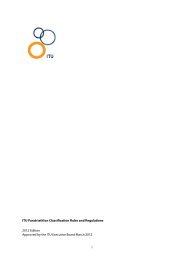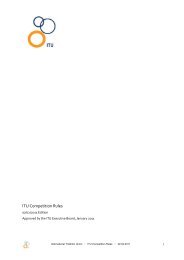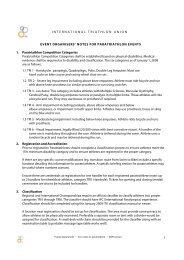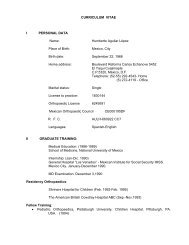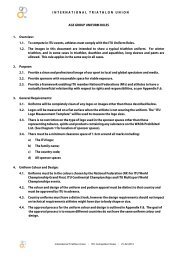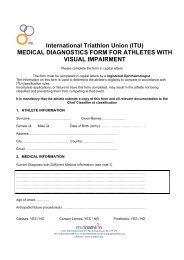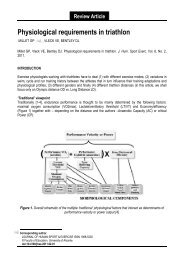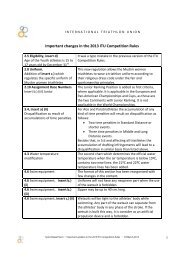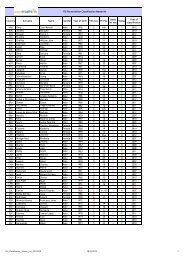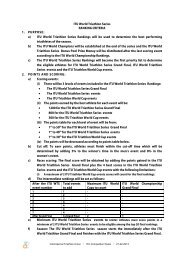Triathlon: swimming for winning
Triathlon: swimming for winning
Triathlon: swimming for winning
Create successful ePaper yourself
Turn your PDF publications into a flip-book with our unique Google optimized e-Paper software.
Review Article<br />
<strong>Triathlon</strong>: <strong>swimming</strong> <strong>for</strong> <strong>winning</strong><br />
JAN OLBRECHT 1<br />
Faculty of Biological Engineering, KULeuven, Belgium<br />
ABSTRACT<br />
Olbrecht J. <strong>Triathlon</strong>: <strong>swimming</strong> <strong>for</strong> <strong>winning</strong>. J. Hum. Sport Exerc. Vol. 6, No. 2, 2011. Swimming<br />
per<strong>for</strong>mance in triathlon gradually gets of overriding importance in view of the final positioning in a race. It is<br />
important to end up <strong>swimming</strong> in the leading group(s) and to consider the impact of the swim stage on the 2<br />
remaining sports disciplines in order to outbalance the athlete’s ef<strong>for</strong>t and to be able to keep racing <strong>for</strong> a<br />
good position until the end of the race. Unlike cycling and running where the per<strong>for</strong>mance mainly depends<br />
on conditioning, the per<strong>for</strong>mance in <strong>swimming</strong> is a subtle combination of conditioning and technical<br />
abilities. Even elite swimmers may lose a lot of per<strong>for</strong>mance if their outstanding conditioning is not coupled<br />
with an excellent <strong>swimming</strong> technique. Triathletes very often suffer from a lack of technique and despite the<br />
wetsuit, which partially outbalances this shortcoming, they spend a lot of energy in the swim stage without<br />
reaping any success, energy which is then not on hand anymore <strong>for</strong> the rest of the race. There<strong>for</strong>e,<br />
<strong>swimming</strong> technique should be the groundwork in the multi-year planning AND should be focussed on in<br />
each training session during the whole carrier of the triathlete. Monitoring the combination of time/stroke<br />
rate/stroke length is thus a must. Periodisation in triathlon is much more complex than in “single” sports.<br />
Not only the sports specific weaknesses/strengths of the athlete but also the intrinsic interaction between<br />
cycling, running and <strong>swimming</strong> on training effects and his swim-technical qualities will rule the<br />
periodisation. Additionally the level of technique will also set volume, intensity and <strong>for</strong>m of training<br />
exercises. Simple to complex tests can help to make the right choice. This makes from triathlon an exciting<br />
sport, not only <strong>for</strong> the athlete but also <strong>for</strong> the coach and supporting teams. This article will summarise some<br />
practical implications on periodisation and on <strong>swimming</strong> training in triathlon. Key words: TECHNIQUE,<br />
PERIODISATION, TRAINING MONITORING, SWIMMING<br />
1 Corresponding author. Diepestraat 7a, B-3090 Overijse. Belgium.<br />
E-mail: j_olbrecht@hotmail.com<br />
JOURNAL OF HUMAN SPORT & EXERCISE ISSN 1988-5202<br />
© Faculty of Education. University of Alicante<br />
doi:10.4100/jhse.2011.62.04<br />
VOLUME 6 | ISSUE 2 | 2011 |<br />
i
Olbrecht J / <strong>swimming</strong> <strong>for</strong> <strong>winning</strong><br />
JOURNAL OF HUMAN SPORT & EXERCISE<br />
INTRODUCTION<br />
Over the last years, <strong>swimming</strong> per<strong>for</strong>mance in triathlon gradually gets of overriding importance in view of<br />
the final positioning in a race. The shorter the triathlon event, the more triathletes , and men even more<br />
than women, need to be in the front at the end of the swim stage in order to start cycling in the leading<br />
group and so to make the most of their chances <strong>for</strong> an optimal final positioning (Vleck, 2008). It has been<br />
suggested, on the basis of higher lactate values after <strong>swimming</strong> than after the cycling and running stage,<br />
that the <strong>swimming</strong> ef<strong>for</strong>t affects the physiological reaction and the mechanical per<strong>for</strong>mance during the rest<br />
of the race (Bentley, 2002; Margaritis, 1996; Millet, 2001; Kreider, 1988a; Farber, 1991; Laursen, 2000).<br />
Un<strong>for</strong>tunately solid evidence <strong>for</strong> this suggestion was missing in these studies. The results varied due to<br />
methodological issues such as control on volume and intensity. Delextrat et al. (2003) provided serious<br />
evidence. They demonstrated that a similar cycling per<strong>for</strong>mance resulted in a significantly higher oxygen<br />
uptake, ventilation, respiration and heart rate when it was preceded by a short (intensive) swim of 750m at<br />
competition pace than when it was headed by a warming up on the ergo-cycle. They estimated a 15.5%<br />
lower mechanical efficiency. Interesting was that <strong>swimming</strong> arms alone during the same time period of the<br />
750m swim, revealed a similar negative impact while intensive swim-kicking did not affect the physiological<br />
activity nor the per<strong>for</strong>mance during cycling. Longer swim distances and lower relative intensities in both<br />
<strong>swimming</strong> and cycling seem to lower the degradation of mechanical efficiency and/or power output<br />
(Laursen, 2000).<br />
Similar increases of metabolic activity <strong>for</strong> running after cycling were also observed (Hue, 1998; Kreider,<br />
1988b). Reasons <strong>for</strong> the negative impact of a swim exercise on the remaining stages are suggested to be<br />
due to thermoregulation (increase of body temperature) (Kreider, 1988a; Delextrat, 2003), respiratory<br />
muscle fatigue (more intensive work of respiratory muscles during <strong>swimming</strong>) (Coast, 1993; Holmer, 1972;<br />
Mador, 1971; Delextrat, 2003) and the perturbation of muscle functionality (Bohnert, 1998).<br />
Unlike cycling and running where the per<strong>for</strong>mance mainly depends on conditioning, the per<strong>for</strong>mance in<br />
<strong>swimming</strong> is a subtle combination of conditioning and technical abilities. For moderate to good swimmers<br />
the strong and consistent presence of stroke indices in the prediction models <strong>for</strong> 50 to 500 yard<br />
per<strong>for</strong>mances suggest that both stroke rate and length are among the primary determinants of <strong>swimming</strong><br />
per<strong>for</strong>mance. Depending on the distance of the <strong>swimming</strong> per<strong>for</strong>mance these 2 variables may place<br />
differential demands on the reliance of particular energy system (Nagle, 2004). This can be extrapolated to<br />
elite swimmers. Their physiological capacities and power are very similar but the winners of big events are<br />
those who can keep stroke length and rate until the end of the race (row data Haljand, 2010). Building<br />
technical swim abilities should best be started at a young age and requires a lot of time. Since most<br />
triathletes do not complete this major training process, they do miss technical background which is a<br />
handicap not only <strong>for</strong> their competition per<strong>for</strong>mance but also <strong>for</strong> their trainability.<br />
A wetsuit can partially outbalance the lack of swim technique. Tomikawa (2009) found the improvement of<br />
<strong>swimming</strong> per<strong>for</strong>mance in triathletes wearing a wetsuit not to be associated with physiological factors but<br />
with propulsion efficiency related to a gain in buoyancy and to drag reduction. No difference in VO 2max<br />
during a continuous progressive <strong>swimming</strong> test was found between <strong>swimming</strong> with a swimsuit (SS: 58.7 +<br />
3.6 ml·min -1. kg -1 ) and a wetsuit (WS: 59.8 + 5.0 ml·min -1·kg -1 ) while blood lactate after a 400 m all out was<br />
1.2 mmol·l -1 higher with WS as compared to SS (SS: 8.0 + 1.0 mmol·l -1 , WS 9.2 + 1.3 mmol·l -1 ). The<br />
incremental blood lactate with WS can only explain a ca 5 s faster time <strong>for</strong> the 400m all-out (Mader, 1980),<br />
but the triathletes swam about 20 s faster as compared to SS. The sprint per<strong>for</strong>mance was also improved<br />
when wearing a WS without enhancing the maximal power output (POmax) nor the active drag (AD), both<br />
measured by the “perturbation method” (De Lucas, 2000). However <strong>for</strong> the same speed AD was decreased<br />
ii | 2011 | ISSUE 2 | VOLUME 6 © 2011 University of Alicante
Olbrecht J / <strong>swimming</strong> <strong>for</strong> <strong>winning</strong><br />
JOURNAL OF HUMAN SPORT & EXERCISE<br />
wearing WS. It was also found that triathletes with less skills in <strong>swimming</strong> achieved greater benefits from<br />
wearing a wetsuit than skilled swimmers.<br />
Another way to quantify the swim-technical per<strong>for</strong>mance is by the IdC, the Index of Coordination (Chollet,<br />
2000). This index consists in the time that separates the beginning of the propulsive phase of one arm and<br />
the end of the propulsive phase of the other arm. It is expressed as a percentage of the mean duration of<br />
the stroke. When there is a lag time between the propulsive phases of the two arms, the stroke<br />
coordination is called “catch-up” (IdC < 0). When the propulsive phase of one arm starts when the other<br />
arm finishes it, the coordination is called “in opposition” (IdC = 0). When the propulsive phases of the two<br />
arms overlap, the coordination is called “superposition” (IdC > 0). The IdC <strong>for</strong> swimmers always increases<br />
with speed (Chollet 2003). For 19 French, Italian and Swiss elite triathletes, the IdC at submaximal swim<br />
speed (ca 84 and 94% of Vmax = 10m sprint between 12.5 and 22.5m) was slightly but not significantly<br />
higher than <strong>for</strong> elite swimmers, but the latest swam significantly faster. At Vmax, the triathletes, however,<br />
showed a significant reduction of IdC while elite swimmers continued to increase it (Figure 1). The lower<br />
<strong>swimming</strong> speed of triathletes was associated with a shorter stroke length (e.g. 1.70 versus 2.10m at<br />
Vmax). Stroke rates were not statistically different (55.1 versus 51.2 str.min -1 at Vmax). With increasing<br />
<strong>swimming</strong> speed, triathletes increased the propulsive time less than the swimmers (3.4 + 4.4% versus 8.5 +<br />
5.8; p
Olbrecht J / <strong>swimming</strong> <strong>for</strong> <strong>winning</strong><br />
JOURNAL OF HUMAN SPORT & EXERCISE<br />
aerobic fitness, but other measures that are less expensive and requiring less experienced manpower such<br />
as peak aerobic power tests can be used. The determination of the peak aerobic power may be an<br />
appropriate measure <strong>for</strong> assessing triathletes since it is predictive <strong>for</strong> the overall triathlon per<strong>for</strong>mance and<br />
even stronger a predictor than VO 2max (Millet, 2003; Millet, 2004).<br />
While VO 2max and peak aerobic power determine the maximal limit of the aerobic per<strong>for</strong>mance, submaximal<br />
tests seem to provide a better prediction of the endurance per<strong>for</strong>mance. Individuals with similar VO 2max can<br />
vary greatly in endurance power depending on the percentage of their VO 2max that they can sustain during a<br />
long lasting event (Costill, 1973; Coyle, 1988; Costill, 1972).<br />
Periodisation in triathlon is much more complex than in “single” sports. Not only the sports specific<br />
weaknesses/strengths of the athlete but also the intrinsic interaction between cycling, running and<br />
<strong>swimming</strong> on training effects and his swim-technical qualities will rule the periodisation. Swimming requires<br />
more “specialist training” to achieve a good aerobic per<strong>for</strong>mance (Roels, 2003). Only little cross-training<br />
benefit from running and cycling is to be expected on <strong>swimming</strong> conditioning (Millet, 2002).<br />
In this article we will work out these considerations in order to find a way to improve the efficiency of swim<br />
training <strong>for</strong> triathletes.<br />
PLANNING AND PERIODISATION<br />
Swimming fast depends on: (1) the ability to produce a high mechanical power output enabling the<br />
generation of high propulsive <strong>for</strong>ces, (2) the ability to reduce drag, while (3) keeping low the power losses<br />
to pushed-away water (Toussaint 2005). These 3 criteria will contribute to a high propulsive swim<br />
efficiency.<br />
This is a very difficult task since no fixed standard <strong>swimming</strong> pattern is applicable <strong>for</strong> all swimmers. Each<br />
swimmer individually has to look with his/her coach <strong>for</strong> the best way of <strong>swimming</strong> in order to meet the 3<br />
requirements above. This is what coaches define as the never-ending-story: continuously looking <strong>for</strong> the<br />
best individual technique of a swimmer. Consequently a lot of time needs to be spent on technique right<br />
from the start of the triatlhete’s development. Thus, the multi-year plan of the triathlete in spe, will contain<br />
many sessions of drills and technique in the <strong>swimming</strong> pool ... but with low volumes. Kyle published a<br />
practical overview of 10 rules to take into consideration on how to build a good swim technique <strong>for</strong><br />
triathletes (Kyle, 2010).<br />
Volume per training will only increase when the quality of the stroke pattern is sufficiently available and<br />
stable. A high mileage of <strong>swimming</strong> be<strong>for</strong>e mastering a good technique will not only prevent the swimmer<br />
from a continuous conditioning improvement over years but also increase the risk of shoulder injuries.<br />
Recording the stroke length is an easy and reliable measure to pragmatically control the stroke quality<br />
(technique). A stroke length near to 2m at submaximal speed should be a benchmark <strong>for</strong> every triathlete<br />
be<strong>for</strong>e considerably increasing mileage and/or intensity of the swim training. Once the triathlete has made<br />
himself familiar with this stroke length, he will be instructed during specific technique sets to increase stroke<br />
rate but at the same time to maintain stroke length. The next step will be to keep the stroke length during<br />
the whole training session, even at higher speeds (e.g. sprints). Thus, the stroke length should first be<br />
improved and only thereafter the stroke rate. This will not only increase <strong>swimming</strong> velocity but will also<br />
provide the triathlete with the skill to adapt his stroke pattern to different <strong>swimming</strong> circumstances (wetsuit,<br />
competing in open water).<br />
iv | 2011 | ISSUE 2 | VOLUME 6 © 2011 University of Alicante
Olbrecht J / <strong>swimming</strong> <strong>for</strong> <strong>winning</strong><br />
JOURNAL OF HUMAN SPORT & EXERCISE<br />
A further increase in stroke length at submaximal speed and the transfer of it into the whole training and/or<br />
into higher intensities will even later on remain important technical objectives <strong>for</strong> swim training. Very often<br />
this requires more swim-kicking support but, as shown in literature (Delextrat, 2003) and corroborated by<br />
the observation in “single” <strong>swimming</strong>, there seems to be more room <strong>for</strong> work by the legs in <strong>swimming</strong><br />
without negatively affecting cycling or running.<br />
In the base period of a macro cycle in triathlon, it is common to focuss on only one discipline per week. This<br />
enables to emphasise the endurance training of that specific sport. If technique development is the main<br />
objective of the <strong>swimming</strong> program, it imperatively should be focussed on in the first week of the meso<br />
cycle and the fractions of the swim set should be kept short. If, however, it is the conditional development of<br />
<strong>swimming</strong> that is the main objective, it can be planned during any week of the working phase of the meso<br />
cycle <strong>for</strong> well technically skilled athletes, while <strong>for</strong> less skilled athletes it should still be scheduled in the first<br />
week of the meso cycle. Moreover longer fractions and/or higher volumes can here be used. For well<br />
technically skilled triathletes <strong>swimming</strong> in the second part of the meso cycle can support recovery.<br />
Anticipating the negative interaction of <strong>swimming</strong> on the physiology and mechanics of running and cycling,<br />
the training intensity in running and possibly in cycling will be reduced in the base period of the macro cycle<br />
if the main focus of the week is on <strong>swimming</strong> or if <strong>swimming</strong> precedes a running or cycling training on the<br />
same day. During the competition preparation phase, the intensity of <strong>swimming</strong> and cycling and/or running<br />
may be high when it is endurance power that is focussed.<br />
In the second part of the base period of a macro cycle it is very useful to stress the metabolic power in<br />
<strong>swimming</strong>. At this stage the athletes are still not too fatigued to per<strong>for</strong>m correctly this kind of swim exercise<br />
and will benefit the most from this type of conditioning training. It will also allow to switch the swim training<br />
objective from “improving” to “maintaining conditioning” once volume/intensity of running and cycling<br />
become more important. This way of periodisation can bypass the rather negative interaction of <strong>swimming</strong><br />
on the training effect of running and cycling and vice versa. In the last meso cycle of the base period, just<br />
be<strong>for</strong>e entering the competition preparation phase, the aerobic capacity has to be re-boosted in <strong>swimming</strong><br />
whereas volume/intensity in running and cycling is minimised. This allows the triathlete to recover from<br />
voluminous work in running and cycling and, at the same time, to refresh the aerobic capacity in <strong>swimming</strong><br />
just be<strong>for</strong>e starting aerobic power in 2 or 3 sports at the same time (grouped).<br />
TRAINING EXERCISES AND TRAINING MONITORING<br />
Exercise volume, intensity, interval (fraction) and rest are the only training elements a coach can modulate<br />
to provoke adaptations in the conditional and technical per<strong>for</strong>mance components. However, the<br />
adaptations to training stimuli vary from one component to the other and from one athlete to the other<br />
regarding response time and amplitude. Consequently the success of training depends on a well balanced<br />
content and timing of training stimuli, tuned to the athlete’s specific needs and training response<br />
capabilities. A systematic program is there<strong>for</strong>e required not only to detect the needs of each athlete<br />
individually but also to monitor the real execution of the training exercises as well as the development of the<br />
main components. This will enable to reveal <strong>for</strong> each athlete the optimal training content and timing.<br />
A scientific training support will not only consist in transferring research findings into training praxis, but also<br />
in applying a scientific methodology to reveal <strong>for</strong> each athlete the priorities as well as the most effective<br />
training structures (periodisation) to meet the training objectives.<br />
VOLUME 6 | ISSUE 2 | 2011 |<br />
v
Olbrecht J / <strong>swimming</strong> <strong>for</strong> <strong>winning</strong><br />
JOURNAL OF HUMAN SPORT & EXERCISE<br />
There is no need <strong>for</strong> huge research to disclose that <strong>swimming</strong> per<strong>for</strong>mance in triathlon (even in the sprint<br />
event) is endurance driven. However, while mainly the aerobic, and to a small extend the anaerobic power,<br />
determine the <strong>swimming</strong> per<strong>for</strong>mance in competition, it is the aerobic and anaerobic capacity that<br />
determine which training objective and what intensity or <strong>for</strong>m of training exercise are most appropriate to<br />
improve competition per<strong>for</strong>mance (Olbrecht, 2000).<br />
According to Mader’s model (Mader, 1984, 2003), firstly published in 1984, which mathematically describes<br />
the regulation of ATP-rephosphorylation in human skeletal muscle during and after exercise, the activation<br />
of the aerobic and lactic anaerobic (glycolysis, pH adjusted) metabolism can be calculated based on their<br />
maximal metabolic activity rate. We there<strong>for</strong>e label both maximal activity rates as respectively the aerobic<br />
or oxidative (VO 2max ) and anaerobic or glycolitic (VLa max ) capacity while the involved part of both capacities<br />
during exercise respectively represents the aerobic and anaerobic power (Olbrecht, 2000).<br />
This model also shows evidence that a given lactate after a submaximal swim may result from many<br />
combinations of maximal oxidative and glycolitic rates. An estimation of the endurance per<strong>for</strong>mance based<br />
on a submaximal per<strong>for</strong>mance at a fix/individual lactate threshold or on a lactate-speed relation will reflect<br />
rather power than capacity. It can there<strong>for</strong>e be a very good prediction reference <strong>for</strong> competition<br />
per<strong>for</strong>mance (Costill, 1973; Coyle, 1988; Costill, 1972) but a very misleading marker to deduce training<br />
intensities or to trace changes in the aerobic and anaerobic capacities (Olbrecht, 2010) due to training.<br />
Literature also shows that a number of factors beside variations in aerobic fitness (Costill, 1973), such as<br />
fibre size (Bishop, 2000) and percentage of type I muscle fibres (Coyle, 1991) may be responsible <strong>for</strong> the<br />
differences in lactate thresholds between subjects.<br />
If different capacities can result in the same lactate-speed relation, it is quite obvious that, despite the same<br />
lactate in training, athletes may undergo different training load depending on their capacities and,<br />
consequently, show different training response (Olbrecht, 2010). This explains the coaches’ remarks that<br />
some triathletes are even unable to complete a swim set at 2 mmol·l -1 .<br />
There<strong>for</strong>e it will be the aerobic and anaerobic capacities and not the lactate-speed relation as such, that will<br />
be predominantly involved to set the training objectives and the range of af<strong>for</strong>dable training intensity and<br />
load (Olbrecht, 2000). Any per<strong>for</strong>mance, however, will depend on the extent to which the athlete appeals to<br />
both capacities. The extent to use both, the aerobic and anaerobic capacities, is considered as respectively<br />
the aerobic and anaerobic power (always part of the capacities).<br />
It is possible to define both capacities using a simulation model based on blood lactate measured after<br />
submaximal exercises (Olbrecht, 1992, 2010). In <strong>swimming</strong> however, the outcome risks a technique bias.<br />
Less swim technically skilled triathletes (un<strong>for</strong>tunately there are many) will rather end up with<br />
underestimated capacities <strong>for</strong> <strong>swimming</strong>. There<strong>for</strong>e this test procedure is rather used in running and<br />
cycling. For <strong>swimming</strong> we are often <strong>for</strong>ced, due to the swim technical weakness of the triathlete, to use a<br />
classic lactate test and to outbalance the lactate-speed relation with an estimation of the aerobic and<br />
anaerobic capacities based on training observations (Capacities’ level chart, Table 1).<br />
vi | 2011 | ISSUE 2 | VOLUME 6 © 2011 University of Alicante
Olbrecht J / <strong>swimming</strong> <strong>for</strong> <strong>winning</strong><br />
JOURNAL OF HUMAN SPORT & EXERCISE<br />
Table 1. Capacities’ Level Chart: chart of criteria to estimate the swimmers’ level (high and low) of aerobic<br />
and anaerobic capacity (Olbrecht, 2000, p 135).<br />
Low A n a e r o b i c C a p a c i t y High<br />
• No better competition per<strong>for</strong>mances after<br />
intense or extensive and voluminous work<br />
• Per<strong>for</strong>ms very good even when not<br />
tapered<br />
High • No real feeling of exhaustion after races<br />
and impression of being able to swim<br />
• Several best times during successive<br />
days of competitions<br />
faster<br />
• Swimmer per<strong>for</strong>ms best in competition<br />
shortly (4-6 days) after voluminous<br />
training<br />
A • Swimmer does not like short interval<br />
workouts or fartlek exercises<br />
E • No clear improvement of competition<br />
results if taper lasts longer than 1 week<br />
R • No high lactates after maximal short as<br />
well as long distance events<br />
O • Competition best times on long distances<br />
are relatively better than on short events<br />
B • Best times in long and short course pools<br />
are nearly the same<br />
I<br />
• Very fast recovery from training and<br />
competition<br />
• Reaches high lactates after short and<br />
long events<br />
• Is fast on short and long events<br />
High<br />
A<br />
E<br />
R<br />
O<br />
B<br />
I<br />
C<br />
• Develops overuse-injuries easily<br />
• Reaches high lactates after short and<br />
rather low values after long events<br />
• Swimmer “dies” in last part of event<br />
C<br />
• No high lactates after maximal short<br />
events, but high values possible after long<br />
events<br />
Low • Bad results on long events and moderate<br />
per<strong>for</strong>mances in short competitions<br />
• Slow recovery from training and<br />
competition<br />
• Only 1 (or 2) good events in competitions<br />
of more than 1 day<br />
• Bad results on long events but very good<br />
in short races<br />
• Best per<strong>for</strong>mances after long rest<br />
Low A n a e r o b i c C a p a c i t y High<br />
Low<br />
However, it would be too simplistic to assume that the coach's job only consists in improving both the<br />
aerobic and anaerobic capacities. Both capacities need to be developed in the right proportion to each<br />
other in order to achieve the best per<strong>for</strong>mance in competition. A long distance athlete with a too high<br />
anaerobic capacity <strong>for</strong> example, will not be able to activate his aerobic capacity to its highest level. He will<br />
VOLUME 6 | ISSUE 2 | 2011 |<br />
vii
Olbrecht J / <strong>swimming</strong> <strong>for</strong> <strong>winning</strong><br />
JOURNAL OF HUMAN SPORT & EXERCISE<br />
show a poor aerobic power and there<strong>for</strong>e per<strong>for</strong>m poorly in long distance competitions despite a good<br />
aerobic capacity. So, according to the outcome of both capacities, the main conditioning objective <strong>for</strong> a<br />
triathlete might be to increase further both capacities, to increase the aerobic capacity while suppressing<br />
the anaerobic capacity, or to improve aerobic power while maintaining the aerobic capacity. According to<br />
the main training objective and the level of capacities volume, intensity, fraction and rest will then be<br />
modulated (Table 2).<br />
Table 2. Classification of training exercises according to their main training effect (improving the aerobic or<br />
anaerobic capacity, or the aerobic or anaerobic power) and with the description of volume, intensity,<br />
Interval (fraction) and rest <strong>for</strong> each class.<br />
Classification of Training Exercises<br />
Aerobic Anaerobic Aerobic Anaerobic<br />
Capacity (=AEC) Capacity (=ANC) Power (=AEP) Power (=ANP)<br />
Type of<br />
S L S L (S) M L S M (L)<br />
swimmer<br />
Volume*<br />
Long<br />
Very High<br />
Moderate<br />
High<br />
110-90% Comp. distance<br />
110-90% Comp. distance<br />
Interval<br />
Short<br />
(100-300m)<br />
Long<br />
(300-800m)<br />
Very Short<br />
(25-75m)<br />
Short progresses to Long<br />
(50-100m) => (100-300m)<br />
Short<br />
(25-100m)<br />
Intensity<br />
Extensive alternated<br />
with intensive and short<br />
intervals in the same or<br />
next training session<br />
Intensive nearly all-out<br />
Race Pace<br />
or somewhat faster<br />
All-out<br />
Rest<br />
(40-20s)<br />
Short<br />
(20-10s)<br />
Long >= 2x swim time<br />
(35s-1:30min)<br />
Short<br />
progress. to very short<br />
(45-30s) => (10-20s)<br />
Short<br />
(10-20s)<br />
Example<br />
8x100m<br />
R=20s<br />
1,3 fast<br />
6x500m<br />
R=20s<br />
1,2 (50fast/50slow)<br />
6x(3x50m)<br />
R=1:20min<br />
P/3<br />
4x3x50m<br />
All Out<br />
R=60s<br />
5x75m R=45s<br />
to<br />
3x125m R=15s<br />
12x100m R=30s<br />
to<br />
5x300m R=20s<br />
Brokens / Comp.Test<br />
4x50m R=10s<br />
25+50+25+50m R=5-10s<br />
*depends on conditioning level<br />
Sprint and technique are not in this classification<br />
Adapted: J. Olbrecht:Schwimmen, Lernen und Optimieren 1994<br />
Beside lactate; other measures like the maximal per<strong>for</strong>mance in an extended exercise (e.g. Cooper test,<br />
...), the heart rate or gas-exchange (ergo-spirometry) are certainly useful to support the optimisation of the<br />
training efficiency. However they all have their advantages and disadvantages. It is there<strong>for</strong>e very important<br />
to use these measures appropriately in accordance with the reliability of in<strong>for</strong>mation they provide (Table 3).<br />
viii | 2011 | ISSUE 2 | VOLUME 6 © 2011 University of Alicante
Olbrecht J / <strong>swimming</strong> <strong>for</strong> <strong>winning</strong><br />
JOURNAL OF HUMAN SPORT & EXERCISE<br />
Table 3. Main outcome with advantages and disadvantages of different ways to assess the aerobic<br />
endurance and to monitor endurance training.<br />
OUTCOME<br />
PRO<br />
CON<br />
Maximal<br />
exercise test<br />
extended<br />
1. Metabolic power as<br />
predictor <strong>for</strong> maximal<br />
per<strong>for</strong>mances<br />
2. Rough estimation of<br />
training intensity and<br />
competition<br />
per<strong>for</strong>mance<br />
• Sport specific<br />
• Non invasive<br />
• Very easy to carry out<br />
• Reflects indirectly the<br />
limit of metabolic<br />
power<br />
• Motivation influences<br />
results<br />
• No detailed assessment<br />
of aerobic and<br />
anaerobic activity<br />
Lactate test Heart rate test Ergo-spirometry<br />
Detailed in<strong>for</strong>mation on<br />
metabolic profile/activity<br />
to determine:<br />
1. objectives &<br />
periodisation<br />
2. intensity & exercise<br />
<strong>for</strong>m<br />
• Sport specific<br />
• Easy to carry out<br />
• Motivation independent<br />
(if submaximal)<br />
• Very complex and<br />
difficult interpretation<br />
Holistic impact on the<br />
athlete regarding:<br />
1. training load<br />
2. recovery<br />
3. environment<br />
• Sport specific<br />
• Very easy to<br />
record<br />
• Complementary to<br />
metabolic data<br />
• Aerobic and anaerobic<br />
activity<br />
• Most direct measure<br />
of<br />
aerobic<br />
endurance<br />
• Reflects metabolic<br />
power<br />
• If used to identify • Rarely sport specific<br />
types/intensity of • Experienced people<br />
training exercises needed<br />
• Accuracy of devices<br />
• VO 2 max vs VO 2 peak<br />
confusion<br />
The maximal extended exercise test is the easiest to carry out; no special expertise is required to do such a<br />
test and it is almost sport specific. It needs however a high commitment of the athlete to go all-out in order<br />
to obtain reliable results. It is the most indirect way to assess the aerobic endurance but you will not be able<br />
to estimate the exact contribution of the aerobic and anaerobic metabolism. To assess training intensity (%<br />
of maximal per<strong>for</strong>mance), the per<strong>for</strong>mance in a maximal extended exercise test is more reliable than heart<br />
rate.<br />
The in<strong>for</strong>mation provided by the heart rate gives an excellent indication of the general fitness of an athlete<br />
and a good reflection on how the body is assimilating training in combination with the environment. The<br />
estimation of training intensity <strong>for</strong> athletes based on heart rate, however, lacks any scientific validity. Many<br />
have tried to relate heart rates to the metabolic characteristics of a specific ef<strong>for</strong>t or exercise but in fact,<br />
despite a same heart rate, different <strong>for</strong>ms of exercises will induce different metabolic responses. Heart rate<br />
increases when an athlete works harder/longer, but the metabolic significance of a given ef<strong>for</strong>t cannot be<br />
deduced by means of heart rate frequencies. Pragmatically, variations in heart rate in training may still be<br />
beneficial in terms of variations in training intensity (primary requirement <strong>for</strong> supercompensation), but a<br />
coach will never be able to define correctly the type of metabolic activity nor its extend that goes together<br />
with a given heart rate. Within this metabolic perspective, training intensities expressed as a percentage of<br />
the maximal per<strong>for</strong>mance of an extended test are there<strong>for</strong>e more reliable.<br />
VOLUME 6 | ISSUE 2 | 2011 |<br />
ix
Olbrecht J / <strong>swimming</strong> <strong>for</strong> <strong>winning</strong><br />
JOURNAL OF HUMAN SPORT & EXERCISE<br />
The use of heart rate or its derivates reflecting the activity of the autonomic nervous system (ANS),<br />
however, may be useful to design and control individual training (Garet, 2004). Swim per<strong>for</strong>mance was<br />
found to correlate individually with nocturnal ANS activity as reflected by Heart Rate Variability indices.<br />
Indeed the decrease in ANS activity during intensive training correlated with the loss of per<strong>for</strong>mance and<br />
the rebound in ANS activity during tapering with the gain in per<strong>for</strong>mance. Interestingly, the speed of the<br />
rebound during the tapering period varied from swimmer to swimmer. Other derivates of ANS activity such<br />
as EPOC, nocturnal recovery index ... may also enable to assess training load (Kaikkonen, 2010) and<br />
recovery from training load (Kaikkonen, 2007) and so to adjust training programs according to the athletes’<br />
training-response capacity. Over the last years, power output and heart rate recovery (the change in heart<br />
rate in the 60 s of recovery immediately after exercise) <strong>for</strong> 3 submaximal ef<strong>for</strong>ts carried out at a pre-fixed<br />
percentage of the maximal heart rate (LSCT; Lambert Submaximal Cycle Test (Lamberts, 2010)) have<br />
been investigated to assess recovery during some weeks of training. In triathlon this procedure may be of<br />
interest <strong>for</strong> cycling or running but <strong>for</strong> <strong>swimming</strong> the first question that has to be solved is whether the<br />
outcome is biased by the variation in swim efficiency or not.<br />
Ergo-spirometry is the most direct way to measure oxygen uptake and aerobic endurance power. But,<br />
strong expertise is needed to per<strong>for</strong>m the test correctly and even despite good practice and equipment, the<br />
accuracy of oxygen uptake measurements remains lower than of biochemical analyses. Based on an<br />
accuracy of +2% <strong>for</strong> lactate (Gutmann, 1974; D’Auria, 2000) and of +0.04% <strong>for</strong> the oxygen uptake<br />
measurements, the accuracy-dependent difference in per<strong>for</strong>mance is 5 times higher <strong>for</strong> oxygen uptake<br />
measures than <strong>for</strong> lactate. In <strong>swimming</strong> and running practice, this means that respectively an error in<br />
per<strong>for</strong>mance of 1s/100m and 5s/km is related to the accuracy of the measurement and that, using<br />
spirometry, it is not possible to make a distinction in per<strong>for</strong>mance between athletes if, e.g. their running<br />
per<strong>for</strong>mance does not differ with more than 5s/km. With lactate measures on the contrary, it is possible to<br />
acknowledge differences in running per<strong>for</strong>mance of 1s/km between athletes.<br />
A measured oxygen uptake always refers to that part of the aerobic capacity the athlete appeals to.<br />
There<strong>for</strong>e this measure reflects the aerobic power and not the aerobic capacity. We there<strong>for</strong>e like to label<br />
the highest measured oxygen uptake as VO 2peak and not as VO 2max . The benefit of the in<strong>for</strong>mation <strong>for</strong><br />
training optimisation provided by ergo-spirometry does rarely compensate its restricted sports specificity<br />
and time consuming procedure. There<strong>for</strong>e, it is preferable to do this type of test only once a year or even<br />
once every 2 years.<br />
According to the importance of a good swim technique <strong>for</strong> a good <strong>swimming</strong> per<strong>for</strong>mance, stroke<br />
mechanism should constantly be focussed on in training, whether it is regeneration or intensive work that is<br />
on the program. Less swim skilled triathletes can use “golf-<strong>swimming</strong>” to support their motor-learning <strong>for</strong> an<br />
efficient swim stroke (Kyle, 2010); the swimmer who can make the smallest sum of swim time added to the<br />
number of strokes wins. Counting the strokes remains <strong>for</strong> all levels of swimmers/triathletes a useful tool. It<br />
helps the athlete concentrate on technique during the whole swim set and, combined with the task to<br />
reduce stroke rate <strong>for</strong> the required intensity (swim time), it continuously <strong>for</strong>ces him to look <strong>for</strong> a longer<br />
stroke length. Once the improvement of stroke length is acquired, it is important to return to normal stroke<br />
rates and to limit the gliding or recovery phase. This will avoid an increase of active drag due to the<br />
intracycle-speed variation that is linked with a longer gliding/recovery phase.<br />
Apnea training can also improve stroke length and seems to positively affect <strong>swimming</strong> coordination. After<br />
3 months of breath-hold (apnea) training, <strong>swimming</strong> per<strong>for</strong>mance (clean velocity and 50m time) was not<br />
x | 2011 | ISSUE 2 | VOLUME 6 © 2011 University of Alicante
Olbrecht J / <strong>swimming</strong> <strong>for</strong> <strong>winning</strong><br />
JOURNAL OF HUMAN SPORT & EXERCISE<br />
improved, but stroke rate decreased while stroke length and IdC increased, showing a greater propulsive<br />
continuity of both arms (Lemaître, 2009). The evaluation of the coordination (IdC) is more difficult since a<br />
good analysis requires video analysis which is not always feasible in training.<br />
In contrast to elite swimmers in competition, triathletes do not have an own lane to compete in, nor super<br />
lane-ropes to break waves eliminating as much as possible any external disturbance of the stroke<br />
mechanism. On the other hand, drafting in triathlon <strong>swimming</strong> is allowed in competition and it has been<br />
observed that the use of drafting tactics shows a 3.2% per<strong>for</strong>mance improvement, <strong>for</strong> a 400 m distance,<br />
with a 3.4% stroke frequency reduction and an increase in distance per stroke of 6.2% (Chatard, 1998;<br />
Chollet, 2000). A triathlete must as well be able to maximally exploit the advantage of drafting and of<br />
wearing a wetsuit to cope with all external disturbances during the swim stage. There<strong>for</strong>e he will have to<br />
train flexibility in stroke length and rate appropriately. Group-starts in one lane or even <strong>swimming</strong> closely<br />
side by side during training sets are certainly triathlon specific exercises that will help to provide the<br />
athletes with a stroke rate/length flexibility to cope well with competition situations.<br />
CONCLUSION<br />
Swimming per<strong>for</strong>mance in triathlon gradually gets of overriding importance in view of the final positioning in<br />
a race and although it requires a subtle combination of conditioning and technique, triathletes almost<br />
exclusively focuss on conditioning and too often neglect technique. Planning and periodisation (technique<br />
be<strong>for</strong>e volume) as well as training execution (active concentration on technique) should always provide an<br />
answer to a demand of swim-skill building or automation. The monitoring of training intensity and of the<br />
adaptations should there<strong>for</strong>e not only be focussed on metabolic measures but should always be linked with<br />
a swim technical evaluation. Stroke length seems to be the most important variable that can easily be used<br />
to control and improve the technical per<strong>for</strong>mance of a <strong>swimming</strong> triathlete.<br />
REFERENCES<br />
1. Bentley DJ, Millet GP, Vleck VE, McNaughton LR. Specific aspects of contemporary triathlon.<br />
Sports Med 2002; 32: 1–15<br />
2. Bishop D, Jenkins DG, McEniery M, Carey MF. Relationship between plasma lactate parameters<br />
and muscle characteristics in female cyclists. Med Sci Sports Exerc 2000; 32: 1088–93<br />
3. Bohnert B, Ward SA, Whipp BJ. Effects of prior arm exercise on pulmonary gas exchange kinetics<br />
during high-intensity leg exercise in humans. Exp Physiol 1998; 83: 557–70<br />
4. Chatard JC, Chollet D, Millet G. Per<strong>for</strong>mance and drag during drafting <strong>swimming</strong> in highly trained<br />
triathletes. Med Sci Sports Exerc 1998; 30: 1276–80<br />
5. Chollet D, Chalies S, Chatard JC. A new index of coordination <strong>for</strong> the front crawl: description and<br />
usefulness. Int J Sports Med 2000; 21: 54-9<br />
6. Chollet D, Hue O, Auclair F, Millet G, Chatard JC. The effect of drafting on stroking variations<br />
during <strong>swimming</strong> in elite male triathletes. Eur J Appl Physiol 2000; 82: 413– 7<br />
7. Chollet D, Millet GP, Lerda R, Hue O, Chatard JC. Crawl evaluation with index of coordination. In:<br />
Chatard JC . Biomechanics and Medicine in Swimming IX 2003: 115-20<br />
8. Coast JR, Krause KM. Relationship of oxygen consumption and cardiac output to work of<br />
breathing. Med Sci Sports Exerc 1993; 25: 335–40<br />
9. Costill DL, Thomason H, Roberts E. Fractional utilization of the aerobic capacity during distance<br />
running. Med Sci Sports Exerc 1973; 5: 248–52.<br />
10. Costill DL. Physiology of marathon running. J Am Med Assoc 1972; 221: 1024–9<br />
VOLUME 6 | ISSUE 2 | 2011 |<br />
xi
Olbrecht J / <strong>swimming</strong> <strong>for</strong> <strong>winning</strong><br />
JOURNAL OF HUMAN SPORT & EXERCISE<br />
11. Coyle EF, Coggan AR, Hopper MK, Walters TJ. Determinants of endurance in well-trained cyclists.<br />
J Appl Physiol 1988; 64: 2622–30.<br />
12. Coyle EF, Feltner ME, Kautz SA, Hamilton MT, Montain SJ, Baylor AM, et al. Physiological and<br />
biomechanical factors associated with elite endurance cycling per<strong>for</strong>mance. Med Sci Sports Exerc<br />
1991; 23: 93–107<br />
13. D’Auria S, Gryczynski Z, Gryczynski I, Rossi M, Lakowicz JR.: A Protein Biosensor <strong>for</strong> Lactate,<br />
Analytical Biochemistry 2000; 283: 83–8<br />
14. De Lucas RC, Balikian P, Neiva CM, Greco CC, Denadai BS. The effects of wet suits on<br />
physiological and biomechanical indices during <strong>swimming</strong>. J Sci Med Sports 2000; 21: 1025-30<br />
15. Delextrat A, Bernard T, Vercruyssen F, Hausswirth C, Brisswalter J. Influence of <strong>swimming</strong><br />
characteristics on per<strong>for</strong>mance during a swim-to-cycle transition. Science & Sports 2003; 18: 188-<br />
95<br />
16. Farber HW, Schaefer EJ, Franey R, Grimaldi R, Hill NS. The endurance triathlon: metabolic<br />
changes after each event and during recovery. Med Sci Sports Exerc 1991; 23: 959–65<br />
17. Garet M, Tournaire N, Roche F, Laurent R, Lacour JR, Barthélémy JC, Pichotov V. Individual<br />
Interdependence between Nocturnal ANS Activity and Per<strong>for</strong>mance in Swimmers. Med Sci Sports<br />
Exerc 2004; 36: 2112–18<br />
18. Gutmann I, Wahlefeld AW. Methods of Enzymatic Analysis. Weinheim Germany: Verlag Chemie;<br />
1974, 1464–8<br />
19. Haljand R. LEN Swimming Competition Analysis. c2010; [cited 14 january 2010]. Available from<br />
http://www.swim.ee/competition/index.html<br />
20. Hòlmer I. Oxygen uptake during <strong>swimming</strong> in man. J Appl Physiol 1972; 33: 502–9<br />
21. Hue O, Le Gallais D, Chollet D, Boussana A, Préfaut C. The influence of prior cycling on<br />
biomechanical and cardiorespiratory response profiles during running in triathletes. Eur J Appl<br />
Physiol 1998; 77: 98–105<br />
22. Kaikkonen P, Hynynen E, Mann T, Rusko H, Nummela A. Can HRV be used to evaluate training<br />
load in constant load exercises? Eur J Appl Physiol 2010; 108: 435–42<br />
23. Kaikkonen P, Nummela A, Rusko H. Heart rate variability dynamics during early recovery after<br />
different endurance exercises Eur J Appl Physiol 2007; 102:79–86<br />
24. Kreider RB, Boone T, Thompson WR, Burkes S, Cortes CW. Cardiovascular and thermal<br />
responses of triathlon per<strong>for</strong>mance. Med Sci Sports Exerc 1988; 20: 385–90<br />
25. Kreider RB, Cundiff DE, Hammett JB, Cortes CW, Williams KW. Effects of cycling on running<br />
per<strong>for</strong>mance in triathletes. Annals Sports Med 1988b; 3: 220–5<br />
26. Kyle J. 10 Swim Tips <strong>for</strong> <strong>Triathlon</strong> Training Trifuel c2001-2011; [cited 26 july 2010]. Available from<br />
http://www.trifuel.com/training/triathlon-training/10-swim-tips-<strong>for</strong>-triathlon-training<br />
27. Lamberts RP, Rietjens GJ, Tijdink HH, Noakes TD, Lambert MI. Measuring submaximal<br />
per<strong>for</strong>mance parameters to monitor fatigue and predict cycling per<strong>for</strong>mance: a case study of a<br />
world-class cyclo-cross cyclist. Eur J Appl Physiol 2010; 108: 183–90<br />
28. Laursen PB, Rhodes EC, Langill RH. The effects of 3000m <strong>swimming</strong> on subsequent 3h cycling<br />
per<strong>for</strong>mance: implications <strong>for</strong> ultraendurance triathletes. Eur J Appl Physiol 2000; 83: 28–33<br />
29. Lemaître F, Seifert L, Polin D, Juge J, Tourny-Chollet C, Chollet D. Apnea training effects on<br />
<strong>swimming</strong> coordination. J Strength Cond Res 2009; 23: 1909-14<br />
30. Mader A, Madsen Ø, Hollmann W. Zur Bedeutung der laktaziden Energiebereitstellung fur<br />
Trainings- und Wettkampfleistungen im Sportschwimmen. Leistungssport 1980; 10: 263-79 and<br />
408-18<br />
xii | 2011 | ISSUE 2 | VOLUME 6 © 2011 University of Alicante
Olbrecht J / <strong>swimming</strong> <strong>for</strong> <strong>winning</strong><br />
JOURNAL OF HUMAN SPORT & EXERCISE<br />
31. Mader A. Eine Theorie zur Berechnung der Dynamik und des steady state von<br />
Phosphorylierungszustande und Stoffwechselaktivität der Muskelzelle als Folge des<br />
Energiebedarfs, Habilitationschrift Köln: Deutsche Sporthochschule Köln 1984<br />
32. Mader A. Glycolysis and oxidative phosphorylation as a function of cytosolic phosphorylation state<br />
and power output of the muscle cell, Eur J Physiol 2003; 88: 317-38<br />
33. Mador MJ, Acevedo FA. Effect of respiratory muscle fatigue on subsequent exercise per<strong>for</strong>mance.<br />
J Appl Physiol 1991; 70: 2059–65<br />
34. Margaritis I. Facteurs limitants de la per<strong>for</strong>mance en triathlon. Can J Appl Physiol 1996; 21: 1–15<br />
35. Millet GP, Bentley DJ. The physiological responses to running after cycling in elite junior and senior<br />
triathletes. Int J Sports Med 2004; 25: 191–7<br />
36. Millet GP, Candau RB, Barbier B, Busso B, Rouillon JD, Chatard JC. Modelling the transfers of<br />
training effects on per<strong>for</strong>mance in elite triathletes. Int J Sports Med 2002; 23: 55-63<br />
37. Millet GP, Chollet D, Chalies S, Chatard JC. Coordination in front crawl in elite triathletes and elite<br />
swimmers. Int J Sports Med 2002; 23: 1–6<br />
38. Millet GP, Dreano P, Bentley DJ. Physiological characteristics of elite short- and long-distance<br />
triathletes. Eur J Appl Physiol 2003; 88: 427–30<br />
39. Millet GP,Vleck VE. Physiological and biomechanical adaptations to the cycle to run transition in<br />
Olympic triathlon: review and practical recommendations <strong>for</strong> training. Br J Sports Med 2001; 34:<br />
384–90<br />
40. Nagle EF, Zoeler RL, Robertsen RJ, Chiapetta LB, Goss FL, Moyna NM. Prediction of per<strong>for</strong>mance<br />
using physiological and stroke variables in a sample of adult competitive swimmers. J Swimming<br />
Reasearch 2004; 16: 31-7<br />
41. Olbrecht J, Mader A, Heck H, Hollmann W. The importance of a calculation scheme to support the<br />
interpretation of lactate tests. In: Maclaren D, Reilly T, Lees A (Eds). Swimming Sciences VI,<br />
Biomechanics and Medicine, London, E & F.N. Spon 1992, p. 243-49<br />
42. Olbrecht J. Lactate production and metabolism in <strong>swimming</strong>. In: Seifert L, Chollet D, Mujika I.<br />
World Book of Swimming: From Science to Per<strong>for</strong>mance. Nova Science Publishers 2010. ch. 13<br />
43. Olbrecht J. The science of <strong>winning</strong>: planning, periodizing and optimizing swim training. Antwerp,<br />
F&G Partners 2000<br />
44. Roels B, Schmitt L, Libicz S, Bentley D, Richalet-J-P, Millet G. Specificity of VO 2max and the<br />
ventilatory threshold in free <strong>swimming</strong> and cycle ergometry: comparison between triathletes and<br />
swimmers. Br J Sports Med 2003; 39: 965-68<br />
45. Suriano R, Bishop D. Physiological attributes of triathletes. Jsams 2010; 13: 340-47<br />
46. Tomikawa M, Nomura T. Relationship between swim per<strong>for</strong>mance, maximal oxygen uptake and<br />
peak power output when wearing a wetsuit. Jsams 2009; 12: 317-22<br />
47. Toussaint H, Truijens M. Biomechanical aspects of peak per<strong>for</strong>mance in human <strong>swimming</strong>. Animal<br />
Biology 2005; 55: 17-40<br />
48. Vleck VE, Bentley DJ, Millet GP, Bürgi A. Pacing during an elite distance triathlon: Comparison<br />
between male and female competitors. Jsams 2008; 11: 424-32<br />
VOLUME 6 | ISSUE 2 | 2011 | xiii



